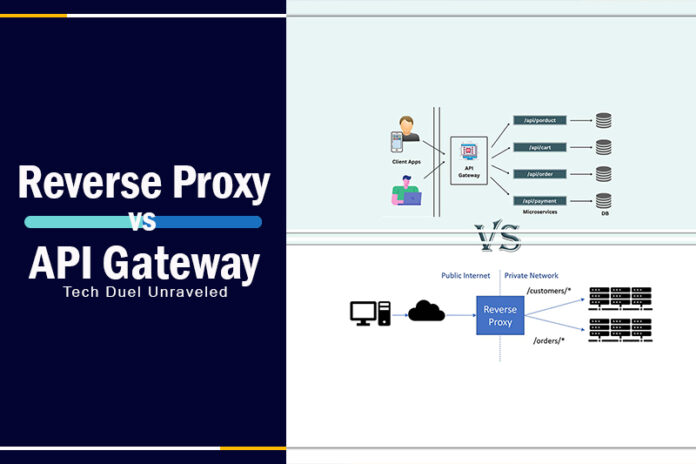Ever found yourself perplexed by the intricate world of server management, especially when terms like ‘reverse proxy’ and ‘API gateway’ come up? “Gateway vs Reverse Proxy” might have left you scratching your head, wondering which solution is the right fit for your needs. If so, you’re not alone.
Dive into our comprehensive guide to understand the “Reverse Proxy vs API Gateway” duel, unraveling their key differences, unique functionalities, and which one aligns best with your tech goals. Whether you’re a budding developer or a seasoned tech guru, this blog is your roadmap to these pivotal server management tools.
What is Reverse Proxy?
A Reverse Proxy serves as a mediator between the client side and one or more backend servers, typically within a corporate environment. Picture a microservice structure – as projects expand, its complexity can increase. Sometimes, the API can become intricate.
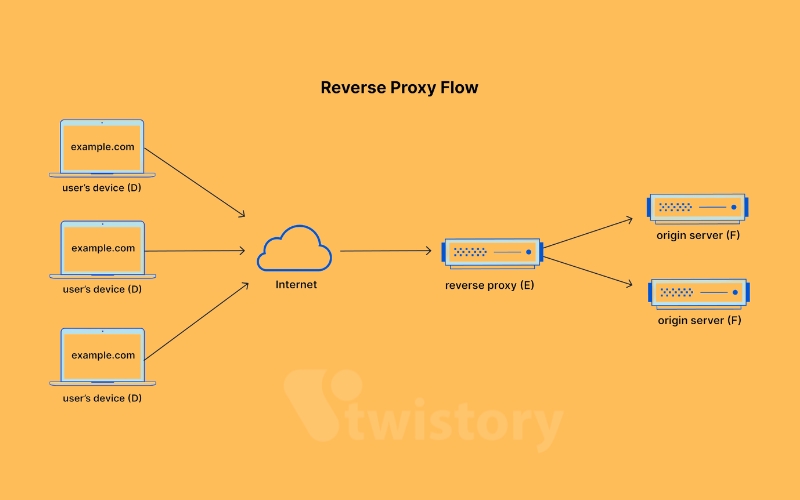
This is where a Reverse Proxy comes into play. It establishes a centralized access point to your file transfer servers, relocates user details to a more secure area, thus mitigating risks to sensitive data, and facilitates seamless backend server maintenance. The benefits of a Reverse Proxy are extensive.
The Reverse Proxy modifies the URLs, all while the client remains oblivious to the backend’s identity. The Reverse Proxy then channels the request to the backend for further processing.
Reverse proxy benefits
The key features of a Reverse Proxy include:
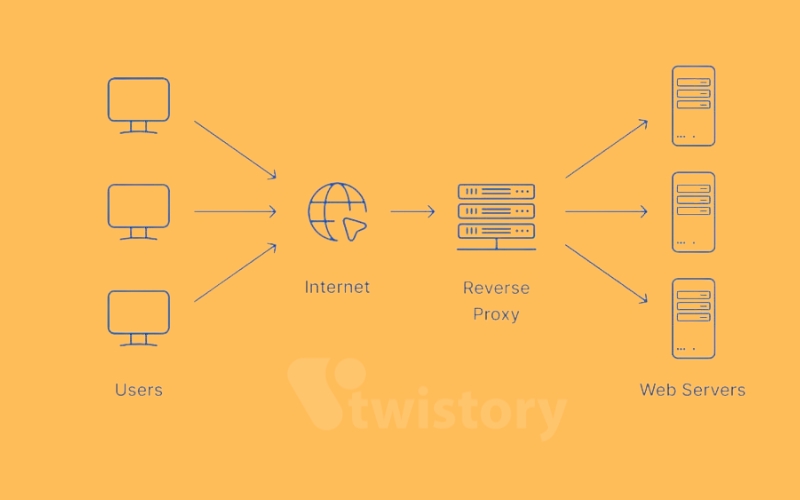
- Security: It provides primary authentication, multi-layered protection against DoS attacks, and SSL certification. While API gateways might fall short in supporting current security measures, reverse proxies can incorporate security systems like packet filtering or antivirus. This acts as a shield for the backend when positioned between the private network and the internet.
- Caching: This enhances performance efficiency by proactively responding to repetitive requests, whether in full or partially. The proxy cache stores content, swiftly replying to the client and lessening the backend data retrieval.
- Load Balancing: A Reverse Proxy can distribute incoming requests across multiple backend servers. This load distribution ensures no single system becomes overwhelmed, thereby avoiding backend outages. If a backend encounters issues, the requests are seamlessly shifted to other operational backends.
- SSL Encryption: Reverse proxies can be configured to decrypt incoming traffic while simultaneously encrypting outbound responses. This optimizes backend resource utilization.
- SSL Termination: Here, the reverse proxy decrypts incoming requests, forwarding the unencrypted data to the web servers. This centralizes the SSL/TLS configuration and management, alleviating web servers from the burden of encrypting and decrypting HTTPS traffic.
- Compression: The reverse proxy can uncompress incoming traffic and compress outgoing data, minimizing the bandwidth for each request.
Pros of a Reverse Proxy
- A straightforward and streamlined tool masking backend server features.
- Execute multivariate and A/B testing without the need for JavaScript embedding.
- Serve dynamic page content, even if generated simultaneously.
- Direct incoming requests via a singular public IP to multiple internal web servers.
- Cost-effective setup and management.
- Basic tools for monitoring and enhancing security.
- Combines multiple websites under one URL domain.
- Facilitates protocol conversion.
- Streamlines request routing.
- Simplifies maintenance operations.
- Boosts load balancing and failover, leading to increased uptime and productivity.
Cons of a Reverse Proxy
- Not as dependable as an API Gateway.
- Potential compatibility issues with SSL offloading apps.
- Superfluous headers between Proxy and Backend Server.
- Limited troubleshooting features, making production issues challenging.
- Constricts load balancing and content delivery options, potentially impacting performance and introducing transaction latency.
What is an API Gateway
While the Reverse Proxy is essential for managing client-to-server communications, the API Gateway takes it a notch higher. Think of it as a microservice intermediary, designed specifically to manage and filter the bulk of traffic while ensuring the highest security measures. It’s particularly beneficial when introducing an API across one or multiple microservices. Mule API proxy vs API Gateway; Plus, it’s user-friendly, making both setup and navigation a breeze.
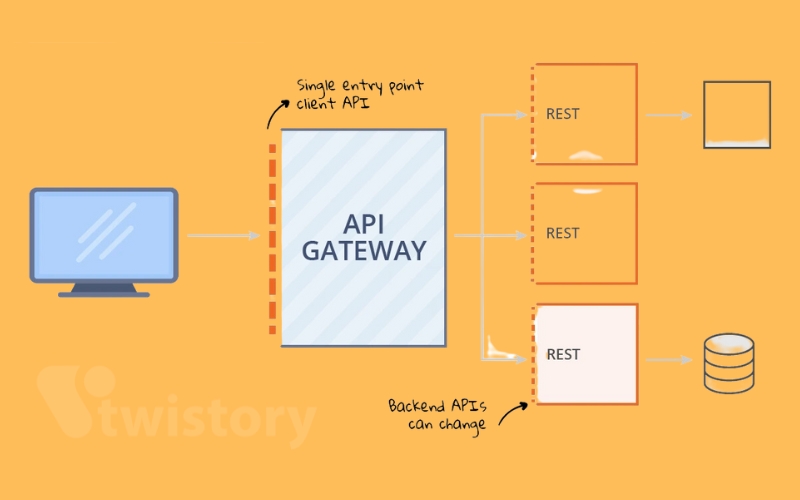
The API Gateway does more than just rerouting requests. It’s adept at aggregation and orchestration, reducing the need for multiple API calls. This means that clients aren’t interacting with numerous backends, but rather, they’re directly communicating with the API Gateway.
One standout feature is Protocol Translation. For instance, the API Gateway can convert protocols, like translating gRPC to JSON, enhancing the harmony between client and server interactions.
API Gateways operate on two modes:
- Initiate the gateway and employ CLI to develop and roll out APIs.
- Generate API metadata gateway configurations and activate them.
Interestingly, manual metadata construction isn’t needed. An API definition is sufficient to set up the API gateway, and service mesh deployments become more streamlined.
API Gateway benefits
API Gateways excel in traceability, observability, scalability, and reliability. For top-tier security and optimal performance, the API Gateway extends:
- Authentication & Authorization: A centralized dashboard to dictate access permissions.
- Refined Code: Enhances code quality for both services and clients.
- IP Whitelisting: Restricts API access to specific IPs.
- Comprehensive Metrics: A detailed analysis of traffic and interactions.
- Rate Limiting, Quotas, and Throttling: Tailor rate limits based on server capacity over designated durations. Control client traffic per their plan. By limiting request frequency, accidental DDoS risks are curtailed. This ensures equitable resource distribution, preventing a single client from monopolizing server access.
- Circuit Breaker & Retry Policy: These amplify backend accessibility by avoiding request overloads and auto-retrying client requests when needed.
Furthermore, traceability and observability are enhanced with the API Gateway’s superior logging, tracking, and correlation features. Every incoming request is logged alongside related backend interactions and metrics.
Pros of an API Gateway
- Up-to-date security measures and advanced traffic management.
- Input authentication.
- Metrics analysis.
- Dynamic scalability in response to function and complexity needs.
- Response modulation.
- Crucial in managing intricate API structures.
- Load distribution.
- Efficient caching.
- Custom API adaptability.
- Efficient throttling.
- Advanced request shaping and management.
- Capability for static response management.
- In-depth documentation.
Cons of an API Gateway
- Potential for connection and latency disruptions.
- Setting up and maintaining can be intricate.
- Elevated operational expenditures.
- Performance can occasionally be compromised, affecting the agility and dependability of your software.
Reverse Proxy vs API Gateway
In the dynamic realm of technology, where APIs and microservices are revolutionizing application development, understanding the nuances between API Gateway vs Reverse Proxy becomes crucial. While both serve unique purposes, their distinct features make them suitable for different scenarios.
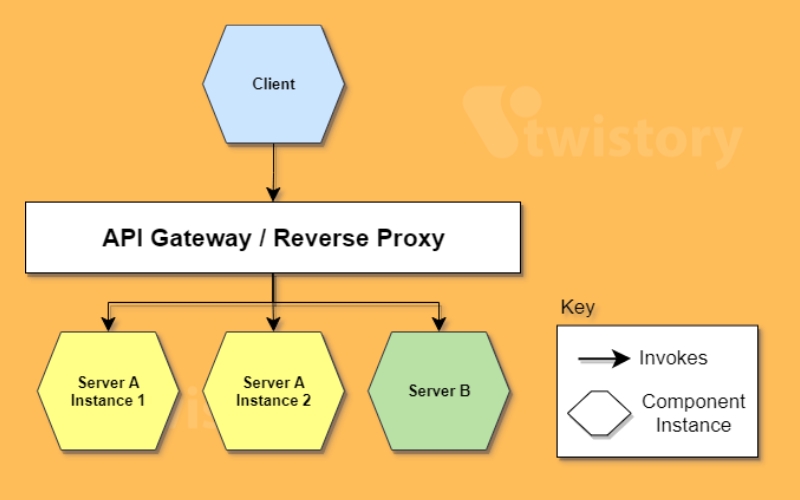
API Gateways, given their comprehensive features, are aptly suited for intricate microservice and API architectures. They can seamlessly perform most tasks a Reverse Proxy is capable of, but the latter’s simplicity and straightforwardness cater to specific needs.
Here’s a comparative rundown:
- Reverse Proxy: Its primary function is to manage internet usage and bandwidth allocation. By doing so, it determines the access and bandwidth permissions for nodes within its protective sphere.
- API Gateway: It is a more versatile tool. Not only does it oversee bandwidth utilization, but it also restricts access to microservices within a safeguarded API framework, particularly for external clientele.
A pivotal distinction is that these two aren’t substitutes for each other. While the API Gateway might appear as an enhanced version of Reverse Proxy, there are instances where the latter’s simplicity is more apt. For example, startups or businesses at the inception of their API journey might find a Reverse Proxy sufficient. Yet, as the enterprise grows and the API lifecycle matures, a transition to a dedicated API Gateway becomes inevitable for efficient management.
Reverse Proxy offers basic measures like TLS (Transport Layer Security) to counteract threats like DDoS attacks. Its core functions encompass performance management, rudimentary security, and authentication. On the other hand, the API Gateway, being a comprehensive tool, not only provides these features but augments them with advanced functions such as superior load balancing, intricate performance tracking, adaptive traffic routing, and orchestration.
In essence, while they share foundational similarities, an API Gateway is like a Reverse Proxy on steroids. When you enhance a simple Reverse Proxy with advanced functionalities such as dynamic configurations, rate limits, service discoveries, and authentications, it metamorphoses into an API Gateway.
Armed with the insights from this guide, you’re now better prepared to make an informed decision. Hungry for more tech knowledge? Dive into other enlightening blogs from Twistory to stay ahead in the ever-evolving world of technology.

